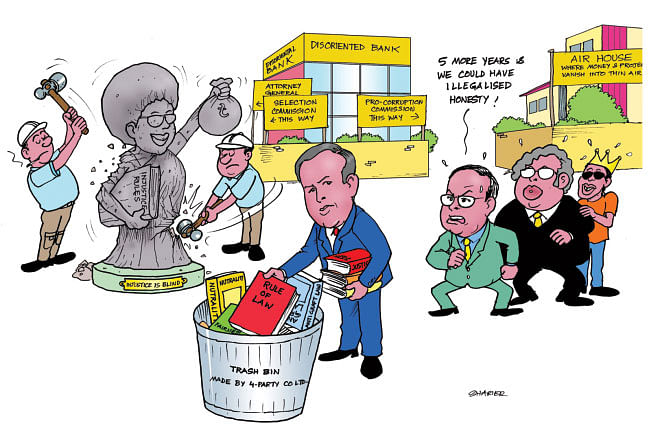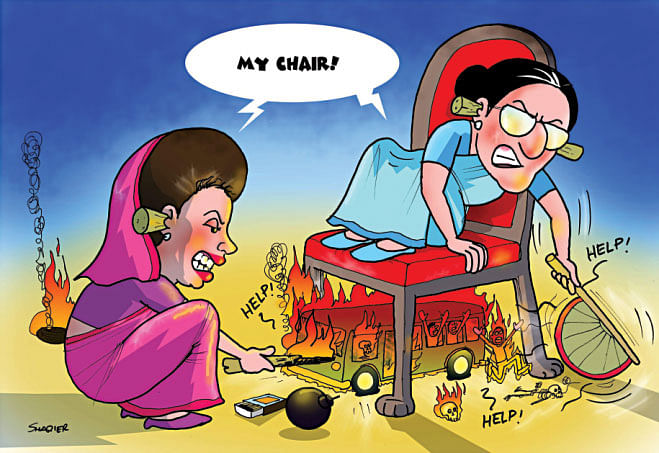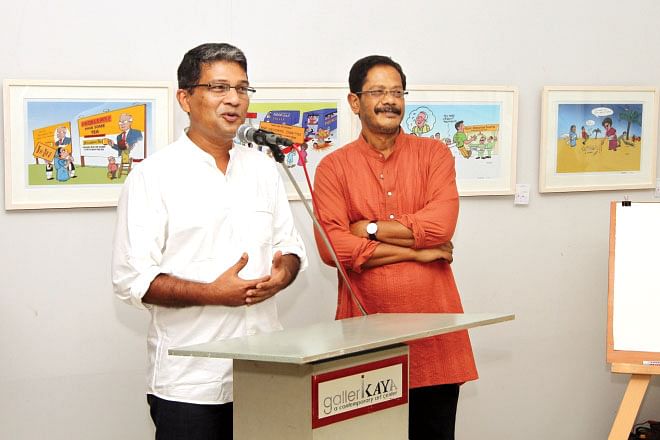Incorrigibly Funny


Political cartoons have always been the most accessible way to expose the gross anomalies of society, namely the unsavoury side of politics. And no one does this better than Sharier Khan whose political cartoons on the front pages of The Daily Star or on the covers of Forum and the Star have become notorious for their boldness and hilarity. Corruption, sycophancy, nepotism, terrorism and state brutality – every kind of evil produced by bad governance, has been captured by Sharier's remarkably witty point of view. An exhibition of Sharier's political cartoons from 2003 to 2014 titled 'Timeline' at Galleri Kaya in Uttara, gives a glimpse of the wild imagination of this avid cartoonist combined with the astute observations of a seasoned journalist. Going through the cartoons artfully displayed at Kaya, is like taking a crash course in recent political history of Bangladesh. Bold, colourful and hilariously irreverent, Sharier's caricature of our mad political scene have delighted the public for years.
Doing political cartoons, however, has been more a consequence of his professional career path rather than a well thought out choice. Studying journalism at Dhaka University, Sharier chose this field over architecture, joining The Daily Star in 1991 as a reporter. He is at present Deputy Editor of the paper and also an analyst on the power sector. His life-long hobby of poking fun at society through cartoons was quickly put to use in the front pages and feature sections of the paper, establishing him as a 'serious' cartoonist. Meanwhile he has brought out a number of graphic novels and continues to contribute with his nonpolitical cartoon strips.

In fact he is currently working on a two-part graphic novel – 'Mission Mars'. It involves futuristic timelines, an espionage mission in Mars, zombies, mutants etc.
So how did it all start?
With a father who was a bookworm, Sharier and his brothers grew up in an environment in which reading was a major source of entertainment. From classics, detective novels, science fiction and of course, comics, Sharier was a voracious reader. Comics though, had a particular attraction for the artistic minded child and the lure of Disney Comics, Marvel Comics, Harvey Comics, Archies and Mad Magazine could not be resisted. Later, during his teens Asterix and Tin Tin became major influences.
Sharier cannot recall exactly when he started drawing cartoons though he does remember making his first 'comic book' when he was merely six or seven.

“Those were kiddy action stuff—but like any comic book I made a cover and drew panels of actions inside” says Sharier. “At that age, I could draw cartoonish faces within seconds—but I could never draw a portrait (till now).”
It was also the time when he delved into writing detective 'novels' which were only about three to four pages long! “My first superhero was born with a name 'Negative'—I don't know why I named him Negative. Though those projects were nonsense and always incomplete—they had an impact on my brothers and my friends—who also began making their own comic books for a while. It was all a creative game.”

During his teen years Sharier switched to funny cartoons as action comics would take a long time to finish: “With gags, I can finish one story in one page.”
From an artistic point of view, Sharier's cartoons are flawless and always aesthetically pleasing. With a natural flair for drawing, Sharier admits that he was hugely influenced by Jack Kirby's impressive depiction of action heroes and later inspired by Hergé (creator of Tin Tin) and Don Martin (Mad).
The collection at this exhibition reveals the cartoonist's talent as an artist as well as his keen observation as a journalist. 'It's all about the chair' shows two irate leading ladies – they both want the chair but one is setting fire to it, using the public as fuel while the other is sitting on it and fanning the fire. It is one of Sharier's most talked about cartoons. The culture of parliament boycott by whoever is in the opposition is aptly depicted in a cartoon of the two women leaders and their men competing in a sporting event – 'Parliament Boycott Tournament' - Khaleda Zia wins this round while her opponent Sheikh Hasina says 'I'll beat you next time'. Well known caricatures created by the cartoonist includes 'Clown Prince' and 'Yesuddin', both based on important players in politics.
What is most delightful about his cartoons is the detailing that goes into each one. In 'Future of Dhaka' – perhaps one of the few non-political cartoons in the exhibition- a myriad of themes are included: Dhaka city, still in the grips of impossible gridlocks, has had to adapt to the extreme: VIPs travel in cable cars and the only greenery seen is on top of buses and other vehicles. Those travelling on 'Awful Express' bus services are as good as dead, in fact, they have been reduced to skull and bones. Even protest rallies by the opposition have to take place on the roofs of vehicles as there is just no more space to even walk.

The exhibition, which was inaugurated by artist and cartoonist Shishir Battacharjee, consists of a limited edition of prints of the cartoons as well as original pen and paper drawings.
Finding humour in harsh reality is a tough job. But it is something that comes naturally to Sharier. Through these cartoons Sharier exposes the inefficiency of our leaders and the insanity of poor governance. But more than that they give a hint of who Sharier Khan is - an incorrigible humourist with an irresistible urge to laugh and make others laugh with him.
The exhibition will go on until June 27th at Galleri Kaya, House 20, Road 16, Sector 4, Uttara.

 For all latest news, follow The Daily Star's Google News channel.
For all latest news, follow The Daily Star's Google News channel. 



Comments